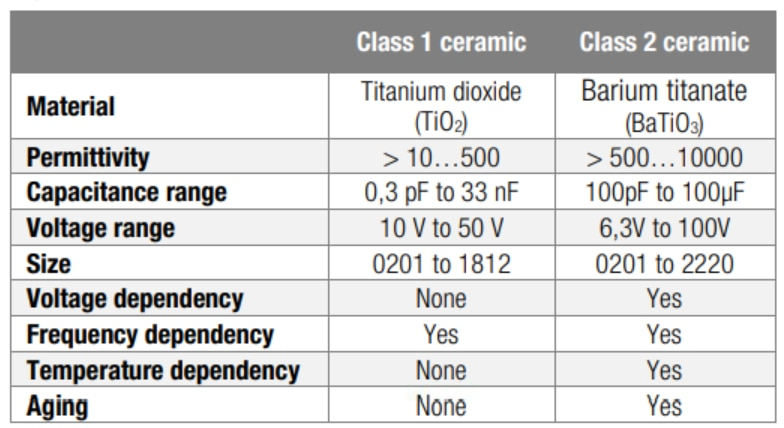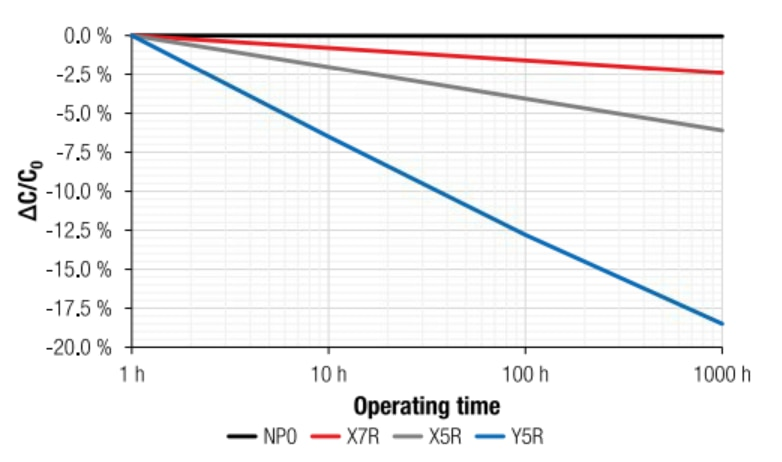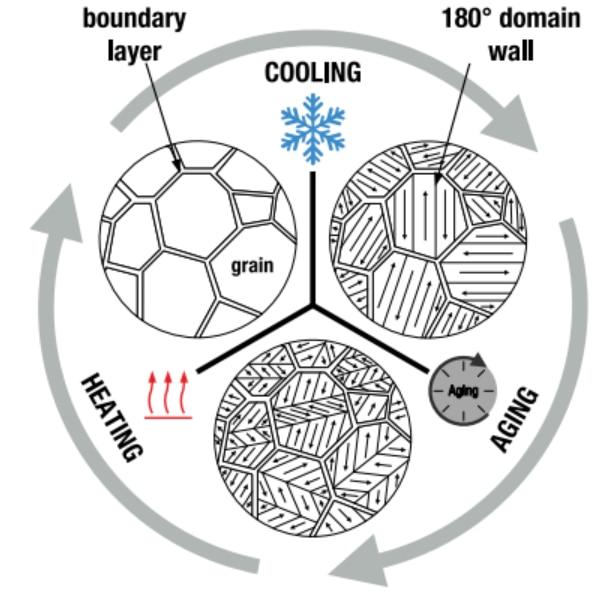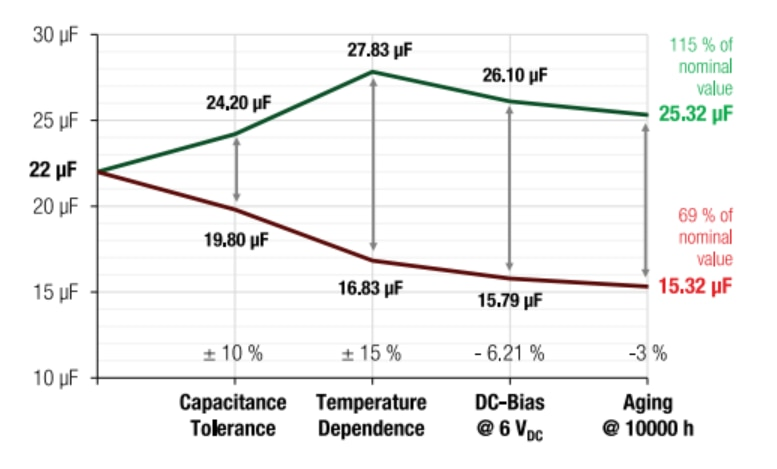
- +86 18120750932
- colin@xmsinuowei.com
- www.xmsinuowei.com

1 Overview about Class 1 and Class 2 MLCCs?
Basically, two types of MLCCSs can be differentiated: capacitors, which are constructed of class 1 or class 2 ceramics. These vary in several aspects as shown in table 1.

Table 1: Overview of the current technical status of the Würth Elektronik eiSos’ ceramics
The properties and tolerances of the different ceramic classes are defined by an IEC or EIA coding. Depending on the application, a certain amount of capacitance must be available to achieve the desired performance in such applications as filters. It is therefore important to compare the properties of the individual components to ensure the desired behavior when used in the application. It should also be mentioned that with high-capacitance MLCCs, the high capacitance is only available with the drawback of increased aging and thus a greater loss of capacitance due to temperature and voltage.
2 Definition of aging
Aging is a process in which certain properties change over time. Ferroelectric materials such as barium titanate are also subject to this process. The crystal structure of the dielectric (in this case barium titanate) changes with temperature and also with time. This is considered aging, since the capacity changes or, more precisely, is reduced by this event. Another result of aging is the increase in the loss factor, which becomes steadily larger. Aging is usually described by a percentage loss of capacitance per decade of time. It is in the range of ~6% after 1000 h for X5R ceramics and ~2.5% after 1000 h for X7R ceramics per decade hours (1-10, 10-100, 100-1000, ...). After realigning the crystal lattice (e.g. by a temperature process that can be repeated as often as desired), aging leads to a loss of capacitance as shown in Figure 1. The process of aging is logarithmic and decreasing with time. It although appears linear on charts when using logarithmic scales.

Figure 1: Capacity loss vs. operating time
3 Why does aging exists for barium titanate?
The permittivity of barium titanate is defined by the polarizability of the material. Further ferroelectric domains are formed by aging. The spontaneous polarization direction changes in such a way that not all dipoles can be polarized "well". The dipoles of two adjacent domains no longer point in the same direction. The result is the reduction of the capacitance. The solution: reformation of the material. The effect of aging is influenced by time, temperature and voltage. Since barium titanate is a ferroelectric material and, like ferrite, has electrical domains, these domains divide with the factor time and thus reduce the capacitance, see Figure 2.

Figure 2: Change of the internal structure
By tempering, the so-called preheating process (heating the material above the Curie temperature), the existing domains dissolve. Below the Curie temperature, the material then forms new large domains again, which in turn results in a high capacity. The thermal movement in the crystal lattice caused by the annealing process prevents the dipoles from aligning completely when an electric field is applied, thus reaching a kind of saturation.
4 How can aging be stopped?
The dielectric used in Class 2 MLCCs has ferroelectric properties. These material properties change when the Curie temperature is exceeded (as with ferromagnetic materials). Above this temperature, the dielectric has a highly symmetrical cubic crystal structure, while below the Curie temperature; the crystal structure has a less symmetrical (tetragonal) structure. The transition from the different phases (cubic to tetragonal etc.) always results in a maximum value of permittivity over this temperature range. To achieve a stable state, the atoms in the crystal lattice move under the influence of thermal vibration for a long time, even after the dielectric has cooled down below the Curie temperature (more and more domains are formed). However, when the capacitor is heated to a temperature above the Curie temperature, aging takes place, i.e. the capacity lost due to aging is regained and aging begins again from the point at which the capacitor cools down again. This temperature is ~125°C for barium titanate. Depending on how long the Curie temperature is exceeded, this results in the capacitance value that is set. According to the data sheet, the recommendation for preheating at 150°C is 1 hour. By this thermal treatment, the maximum 100% capacity of the component can be restored.
5 Effects of aging for the application
In a real application, which contains voltage and is operated at a certain ambient temperature, a reduction in capacity over time must generally be foreseen when using MLCCs. This is unavoidable and is caused by the base material used for Class 2 ceramics. It is now up to the design of the capacitor to compensate for this capacitance loss. A 100% test is performed after manufacture to ensure that all tolerances are met. Depending on storage time and storage conditions, these values may change over time. Due to the heat influence of the soldering process, the aging process is reset (see appendix, example measurement and reflow soldering process for a MLCC with the DateCode 2014). In applications where stable capacitance values are required, aging must be considered or a Class 1 MLCC must be used. If capacitors are used as output capacitors (e.g. in switching regulators), the effect of aging can be best compensated for, as in this case the capacitance fluctuations are in the low single-digit range and therefore have no negative effect on the function of the circuit. The resulting capacitance of an e.g. 22 µF X7R MLCC with all dependencies is shown in figure 3.

Figure 3: Real capacity considering all dependencies
6 Conclusion
The aging is recorded at room temperature (around 20 °C) and ~0 V as applied voltage. At room temperature and ~0 V ceramic capacitors have almost no temperature, DC bias and frequency influences that could influence aging. Below the Curie temperature and after applying a voltage, the existing ferroelectric properties polarize the molecules in a defined manner. The cubic structure becomes a tetragonal structure, which leads to a decrease in permittivity and thus in capacity. What now leads to aging? If the crystal structure of the ceramic is left at room temperature without load, randomly oriented domains are formed in which, in turn, non-directional dipoles are formed, which have a negative influence on the permittivity. These randomly oriented domains "grow" faster at first and then develop more slowly. Therefore, the loss of capacity is shown logarithmically. When a voltage is applied and the temperature is increased, the formation of randomly oriented domains slows down, since the dipoles are aligned in a defined manner by the electric field. In practice, this means that aging as shown in Figure 1 is a “worst case” figure. Since the decrease in capacity via DC bias and temperature is significantly higher than the expected aging, this is assumed a fixed value.
Source:element

Service online